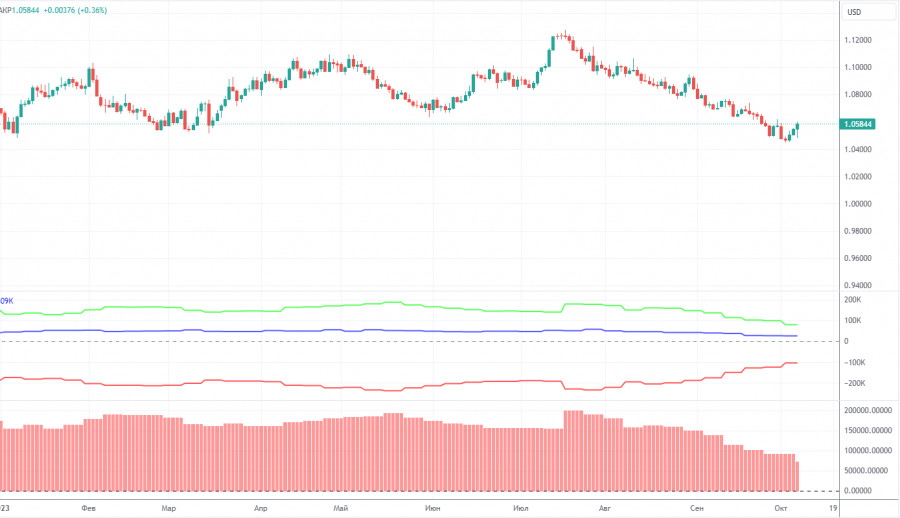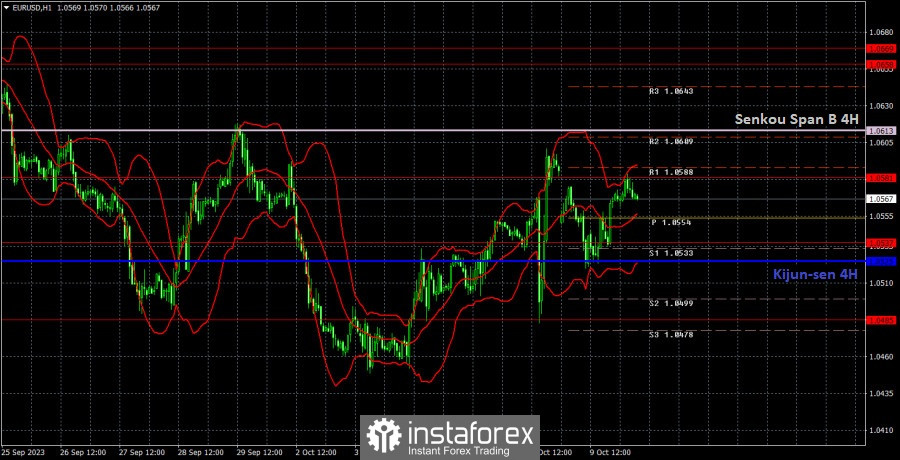

On Monday, EUR/USD showed two very important segments of movement. Despite the lack of significant fundamental and macroeconomic events, the pair started to trade with a downward gap, followed by a bearish retracement, and the upward movement resumed, which is a correction against a two-month decline. So, why was there a gap and retracement? Because the latest US reports (from Friday) were stronger than expected, but instead of rising further, the dollar inexplicably fell by the end of the day. Therefore, the euro had to fall to rectify the situation. So why did the pair resume the upward movement? Because the overall bullish correction was too weak. In addition, gaps tend to be closed, which we also saw by the end of the day. So, from a technical standpoint, yesterday's movements were practically ideal.
In general, only one trading signal was formed. The price stayed in the 1.0525-1.0537 range throughout the European trading session and the beginning of the US session, from which it eventually bounced. It's difficult for us to say how much you could earn from this long position since the pair reached the level of 1.0581 during the night, but you could have gained a few dozen pips. Volatility was 54 pips, which is not surprising given the empty economic calendar.
COT report:
On Friday, a new COT report for October 3rd was released. Over the past 12 months, the COT report data has been consistent with what's happening in the market. The net position of large traders (the second indicator) began to rise back in September 2022, roughly at the same time that the euro started to rise. In the first half of 2023, the net position hardly increased, but the euro remained relatively high during this period. Only in the last two months, we have seen a decline in the euro and a drop in the net position, which we've been waiting for a long time. Currently, the net position of non-commercial traders is still bullish and this trend is likely to lose momentum soon.
We have previously noted that the red and green lines have moved significantly apart from each other, which often precedes the end of a trend. This configuration persisted for over half a year, but eventually, the situation began to change. Therefore, we still stick to the scenario that the upward trend is over. During the last reporting week, the number of long positions for the "non-commercial" group increased by 200, while the number of short positions increased by 19,700. Consequently, the net position by another 19,900 contracts. The number of BUY contracts is higher than the number of SELL contracts among non-commercial traders by 79,000, but the gap is narrowing. In principle, it is now evident even without COT reports that the European currency is set to extend its weakness.
Analysis of EUR/USD 1H
On the 1-hour chart, the pair started a new leg of the bullish correction. We believe that the dollar will continue to advance in the medium term, but we are expecting the pair to rise further in the near future. Even the Non-Farm Payrolls report failed to disrupt the corrective phase. The pair has already crossed the Kijun-sen line, so it may continue to move towards the Senkou Span B line, where the local high is located.
On October 10th, we highlight the following levels for trading: 1.0269, 1.0340-1.0366, 1.0485, 1.0537, 1.0581, 1.0658-1.0669, 1.0768, 1.0806, 1.0868, 1.0935, as well as the Senkou Span B line (1.0613) and the Kijun-sen line (1.0525). The Ichimoku indicator lines can shift during the day, so this should be taken into account when identifying trading signals. There are also auxiliary support and resistance levels, but signals are not formed near them. Signals can be "bounces" and "breakouts" of extreme levels and lines. Don't forget to set a breakeven Stop Loss if the price has moved in the right direction by 15 pips. This will protect against potential losses if the signal turns out to be false.
The only significant event on Tuesday is a speech by European Central Bank President Christine Lagarde. However, we've repeatedly stated that the market currently has a clear understanding of what to expect from the ECB and the Federal Reserve, so the representatives' speeches do not carry much intrigue.
Description of the chart:Support and resistance levels are thick red lines near which the trend may end. They do not provide trading signals;
The Kijun-sen and Senkou Span B lines are the lines of the Ichimoku indicator, plotted to the 1H timeframe from the 4H one. They provide trading signals;
Extreme levels are thin red lines from which the price bounced earlier. They provide trading signals;
Yellow lines are trend lines, trend channels, and any other technical patterns;
Indicator 1 on the COT charts is the net position size for each category of traders;
Indicator 2 on the COT charts is the net position size for the Non-commercial group.